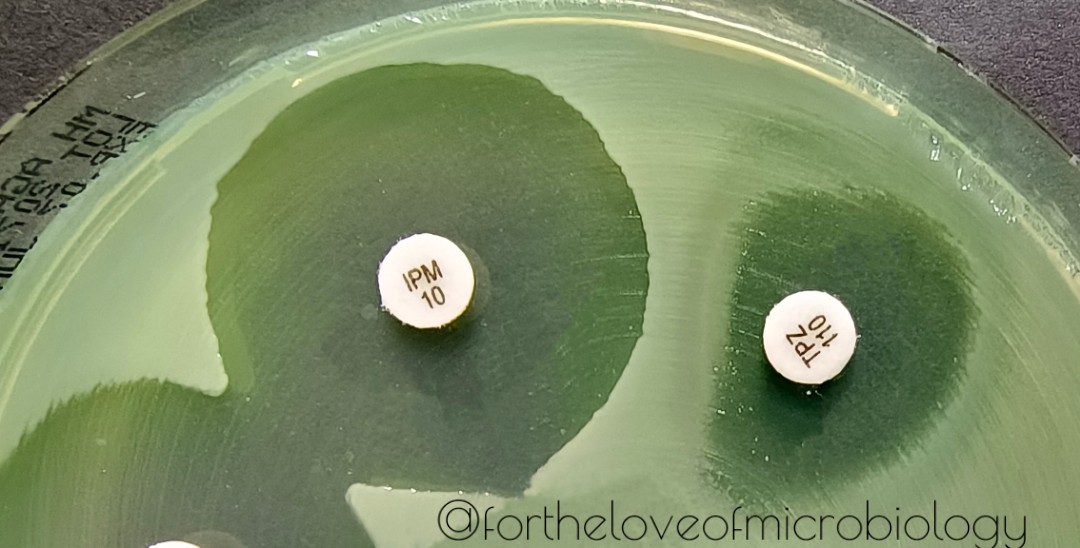
Many times when susceptibility testing is done for P. aeroginosa, a scenario similar to shown in the picture is encountered.
We see that TZP has produced a D shape on the IPM side. This might look very similar to the phenomenon seen in gram positive ICR strains. So what is it?
We see that TZP has produced a D shape on the IPM side. This might look very similar to the phenomenon seen in gram positive ICR strains. So what is it?

Published data says that this result is most likely due to
inducible expression of the P. aeruginosa AmpC beta-lactamase.
inducible expression of the P. aeruginosa AmpC beta-lactamase.
Certain enteric
(Serratia, Providencia, Citrobacter, Enterobacter, Morganella) and non-enteric organisms (P. aeruginosa, Aeromonas) can up-regulate expression of
their chromosomally-encoded ampC genes in response to sub-inhbitory concentrations of certain
b-lactam antibiotics
(Serratia, Providencia, Citrobacter, Enterobacter, Morganella) and non-enteric organisms (P. aeruginosa, Aeromonas) can up-regulate expression of
their chromosomally-encoded ampC genes in response to sub-inhbitory concentrations of certain
b-lactam antibiotics
Although Imipenem is a strong inducer of AmpC expression, it is not a good substrate for the enzyme and is therefore relatively resistant to hydrolysis. This is why you saw a
blunting of the TZP zone, but did not see a blunting of the Imipenem zone itself.
blunting of the TZP zone, but did not see a blunting of the Imipenem zone itself.
Interestingly, the combination of TZP with Imipenem was shown to be the most sensitive antibiotic combination for the detection of inducible AmpC expression in a previously published study (Dunne & Hardin. J Clin
Micro. 2005. 43(12):5945-5949).
Micro. 2005. 43(12):5945-5949).
AmpC beta-lactamase can become stably over-expressed
when mutations are acquired in regulators of ampC expression (de-repressed AmpC
strains).Resistance by this mechanism can occur in some patients receiving certain broad-spectrum
cephs for infections with aforementioned org
when mutations are acquired in regulators of ampC expression (de-repressed AmpC
strains).Resistance by this mechanism can occur in some patients receiving certain broad-spectrum
cephs for infections with aforementioned org
However, there is no CLSI-approved method for the detection of inducible AmpC expression and no
consensus about how to report antibiotics when an isolate is found to have inducible AmpC
expression.
consensus about how to report antibiotics when an isolate is found to have inducible AmpC
expression.
It is also important to keep in mind that the AmpC beta-lactamase has also been mobilized onto a plasmid, conferring high-level expression of this enzyme to organisms that acquire
the plasmid.
the plasmid.
There are some excellent reviews available on AmpC beta-lactamases (e.g. Jacoby GA. Clin Micro Rev. 2009. 22:161-182, Thomson KS. J Clin Micro. 2010. 48(4):1019-25).
#Fortheloveofmicrobiology #clinicalmicrobiology #mmidsp #microrounds #IDpath #ASMClinMicro
#MicroTwitter #WomenInSTEM #WomeninMicrobiology #WomenInMedicine #STEM #sciencetwitter #medtwitter #ClinMicro #microbiologypakistan
#MicroTwitter #WomenInSTEM #WomeninMicrobiology #WomenInMedicine #STEM #sciencetwitter #medtwitter #ClinMicro #microbiologypakistan
• • •
Missing some Tweet in this thread? You can try to
force a refresh




